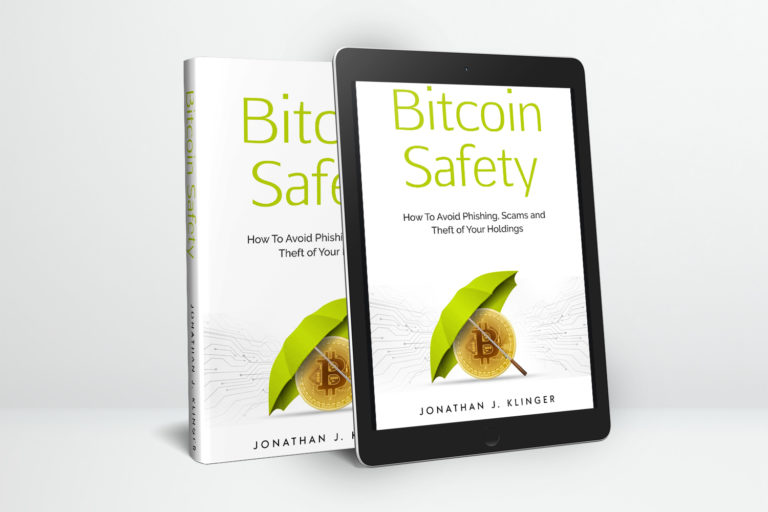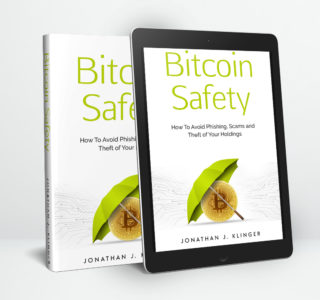
“Bitcoin Safety: How To Avoid Phishing, Scams and Theft of Your Holdings” is a new book by Jonathan J. Klinger, a cyberlaw attorney and crypto-specialist.
This book will teach you how to avoid common scams, how phishing attacks work and how to secure your assets in a way that can prevent future attacks and allow you to recover your coins in case of a disaster.
About the eBook:
- Preface: Why should you read this book?
- About The Author
- Introduction: The Gold Standard
- What is a Bitcoin Wallet?
- How To Manage A Wallet
- Types of Bitcoin wallets
- Keeping your seed safe
- Backup
- Death
- Privacy and Security
- The Five Dollar Wrench Attack
- Physical Security
- Perform Regular Security Audits
- Scams and Phishing
- The Fake Sale of Bank Notes or Products and Services
- The Fake ID and Fake Transfer
- Face-to-Face Robbery
- Send-1-Get-5 Scam
- Ponzi Schemes
- Pyramid Schemes
- Fake Investments
- The Next-Bitcoin Scam
- Pump and Dump
- SIM Jacking
- Fake Wallet Update
- Seed Insertion Scam
- Chrome extension or Mobile App
- Prepackaged Seed
- Seed Stored on a Cloud or PC
- Alternatives
- Custodial Services
- ETF: Exchange Traded Funds
- Hiding Your Capital: Conclusions and Epilogue
So you have some coins you need to protect. In the good old days of 2012, you mined a whole block of bitcoin; or maybe you bought one of the dips in 2015, or 2018, or I don’t know. The thing is, you’re reading this because, like everyone else, something that was worth a couple of thousand dollars until a few months ago is now worth almost a million bucks. You may have invested in a hardware wallet, or had some cybersecurity expert explain things like Shamir Secret Sharing or encryption, but you still need the most important part: how to keep your funds secure.
Theoretically, here would be a ‘look no further’ section, with some reference to quick solutions which include my affiliate code. Hoping that someone stupid enough would buy them and sleep well… Well… until their coins are stolen. But that’s not the case. This guide is not meant to ensure that you have a one-stop-shop solution to answer all your concerns. It is here to raise more concerns. Why? Because, you need to think about protecting your assets. I will offer some tips and tricks, but not enough to establish great protection. If you’re looking for a quick solution, stop reading this and don’t waste your time. Do keep on reading if you’re actually concerned about your coins and want to know what you can do to mitigate risks.
In the good old days, no one really had money. Think of medieval times, or maybe just a century ago. Let’s assume that you’re an affluent person, like a lawyer or a teacher. You save some coins every month and accumulate some wealth. You can’t really invest it in the stock exchange (I mean, you can, but it’s still complicated); and you can put it in a bank. But most likely, if you have enough money, it would be kept in gold reserves. Now, gold has several properties which are similar to bitcoin: it’s fungible, it’s divisible, it has value based on people’s trust, and it is scarce. It is also easy to steal. If you have a safe deposit box with a gold bar, then you need to protect it.
How would you protect a bar of gold? Let’s assume you have the equivalent of one kilogram of gold. This is approximately the equivalent of one bitcoin today, but this may vary in a day or two. First, you need a safe. This safe should be hidden, so that if someone breaks into your home he can’t find it, and it should be attached to your wall. But there’s a problem. Most homes are not built out of concrete, and in the best case scenario, they have cinder blocks. In some cases, they only have wooden walls.
So gold is one option, but people also store cash or other valuables. The same principles should apply.
Let’s assume you have a safe, and it’s actually attached to a wall. The next question is: how much should you invest in a safe? I mean, If all you have is a bar of gold, and these are your life’s savings, should you invest one percent of its value, ten percent of its value or fifty percent of its value to reduce the risk? The average burglary takes less than a quarter of an hour; so theoretically, a good safe would require more than ten minutes to break or detach from the wall. Moreover, assuming that the safe is attached in a way that would require a lot of noise-making to tear from the wall, this would make it safer. How much safer, though? while the average burglary is less than fifteen minutes long, there might be burglaries that last longer; so you would need something to protect yourself from a longer one, either by creating a distraction, or reducing motivation.
Remember, we’re still talking about keeping a gold bar secure, but we will apply this later to your crypto. There are a few factors to consider regarding the safe: whether it is locked by a key (which you might lose, but is hard to crack), a combination (easy to guess), biometrics (where someone can chop a finger to open it up), or a combination of more than one. Some safes have a mechanism which includes a code and a backup key. They are the most common today and you are most likely to buy them. Apart from that, you need to make sure that it is indeed safe: that it is made from durable metal and not some tin-can.
Let’s say you bought a safe and placed it in a hidden location. Why hidden? because even if all other failsafes tumble, and you forget to lock the safe, then a burglar might not find it. Most people and guides suggest hiding it in a cabinet or under something. The problem? Usability versus protection. If you need to attach it to a concrete wall, then this wall might not have the right cabinets to hide the safe.
Buying the safe creates a problem: the company that sold you the safe knows that you bought one. If you paid for a professional installation, then the installer might also know not only that you bought the safe, but where it is. This is a problem, because if only people who owned a gold bar bought a safe, then safe selling stores would be the best target for burglars who look for information. You need to mitigate this. First, if possible, pay for your safe in cash, or some other anonymous form. Second, if (and only if) you believe you can install it better than a professional, do it yourself. I don’t think I personally can, but it’s a different situation for different people.
Note that we’re still in the gold area, because it’s similar to what you should do with your crypto wallet. Let’s recap: A safe should be something hidden from plain sight; it should be good enough to deter a potential quick attack, but might not survive an advanced persistent threat, it should not cost more than the risk it mitigates, and it should be kept confidential. Does this make sense to you? This is the basis of cybersecurity, as well. Things didn’t change that much during the last two centuries. Now, we can move from gold to bitcoin.
About the Author
Author of bestselling privacy policies, as seen on your phone.
Jonathan J. Klinger is an Israeli Cyberlaw attorney and blogger; acting as a legal consultant for several high-tech companies and start-ups. Legal counsel for the Israeli Bitcoin Association, Hamakor, Israel’s Open Source Society, Israel’s Digital Right Movement, and others.
Jonathan taught computer game development law at Beit Berl College and teaches Media Law. Jonathan volunteers at the Digital Rights Movement free speech clinic where he takes cases relating strategic lawsuits against public participation (SLAPP).


